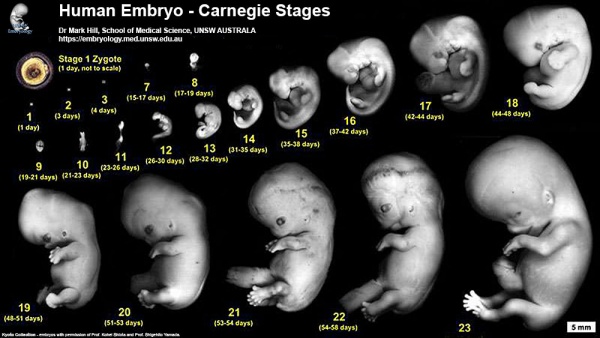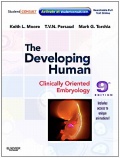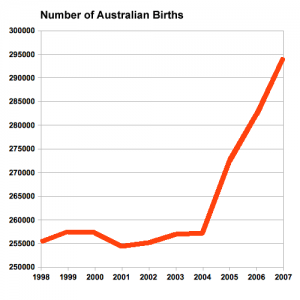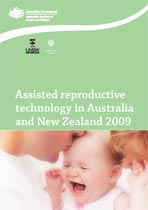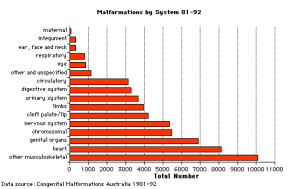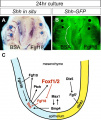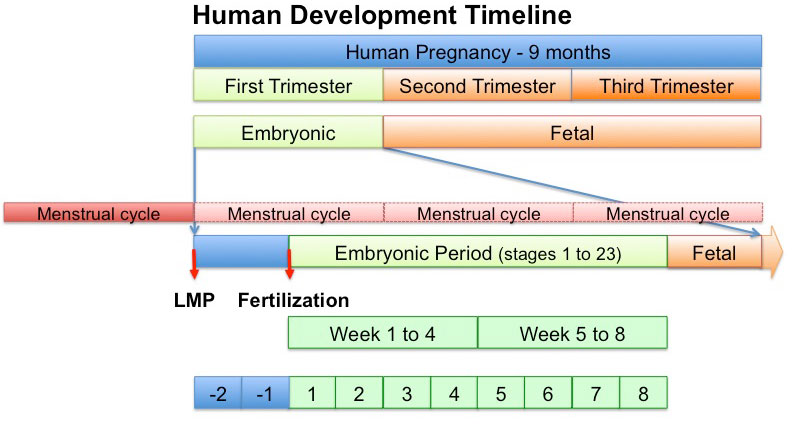Lecture - 2012 Course Introduction: Difference between revisions
| (52 intermediate revisions by the same user not shown) | |||
| Line 1: | Line 1: | ||
= A Course Introduction= | = A Course Introduction= | ||
[[ | {| | ||
| '''From this''' [[File:Early_zygote.jpg|210px]] | |||
| '''to this''' [[File:Newborn.jpg|300px]] '''in 9 months''' | |||
|} | |||
{| | |||
| [[File:Mark_Hill.jpg|100px|Dr Mark Hill]] | |||
Course coordinator | |||
| This first lecture will be a general introduction to the course and the subject of Embryology. | | This first lecture will be a general introduction to the course and the subject of Embryology. | ||
| Line 17: | Line 15: | ||
:'''Secondly''', some historic background to the subject and related current Australian trends. | :'''Secondly''', some historic background to the subject and related current Australian trends. | ||
'''MH''' - I do not expect you to remember specific historic dates or statistical data, this is provided as an introduction to the topic. | |||
|} | |||
==Objectives== | ==Objectives== | ||
# Understand the course objectives and assessment. | # Understand the course objectives and assessment. | ||
# Brief understanding of Australian statistical data. | # Brief understanding of Australian statistical data. | ||
# Broad overview of Human Development. | |||
{| | {| | ||
| [[File: | | [[File:Podcast_icon.jpg|link=ANAT2341_Embryology_2012_Lecture_Recordings]] | ||
| | | '''Lectopia Lecture Audio''' [http://lectopia.telt.unsw.edu.au/lectopia/lectopia.lasso?ut=90&id=138299 Lecture 1 - Course Introduction] | ||
Lecture Date: 2012-05-31 Lecture Time: 17:00 Venue: BioMed F Speaker: Dr Mark Hill | |||
[[ANAT2341_Embryology_2012_Lecture_Recordings|Course Audio]] | |||
|} | |} | ||
| Line 39: | Line 39: | ||
[[File:Human_Carnegie_stage_1-23.jpg|600px]] | [[File:Human_Carnegie_stage_1-23.jpg|600px]] | ||
'''The first 8 weeks of human development.''' | |||
'''Links:''' [[ANAT2341_Embryology_2012|Course Homepage]] | '''Links:''' [[ANAT2341_Embryology_2012|Course Homepage]] | ||
| Line 149: | Line 151: | ||
'''Publisher Links:''' [http://www.us.elsevierhealth.com/product.jsp?isbn=9781416037064 The Developing Human: Clinically Oriented Embryology] | [http://www.elsevier.com/wps/find/bookdescription.cws_home/713963/description#description Larsen’s Human Embryology] | '''Publisher Links:''' [http://www.us.elsevierhealth.com/product.jsp?isbn=9781416037064 The Developing Human: Clinically Oriented Embryology] | [http://www.elsevier.com/wps/find/bookdescription.cws_home/713963/description#description Larsen’s Human Embryology] | ||
== | ==Recent History== | ||
'''1965''' - Neural Crest Research [[Embryology History - Nicole Le Douarin|Nicole Le Douarin]]. | '''1965''' - Neural Crest Research [[Embryology History - Nicole Le Douarin|Nicole Le Douarin]]. | ||
| Line 187: | Line 162: | ||
===Nobel Prizes=== | ===Nobel Prizes=== | ||
[[File:IVF-Louise Brown.jpg|thumb|Louise Brown, the first IVF baby as an adult.]] | |||
Much of the modern history of Medicine/Embryology is documented in the [http://nobelprize.org/nobel_prizes/medicine/laureates/ Nobel Prizes for Medicine]. Remember that these award dates reflect findings that have proven to be scientific key breakthroughs from earlier dates. | Much of the modern history of Medicine/Embryology is documented in the [http://nobelprize.org/nobel_prizes/medicine/laureates/ Nobel Prizes for Medicine]. Remember that these award dates reflect findings that have proven to be scientific key breakthroughs from earlier dates. | ||
| Line 195: | Line 170: | ||
* '''2002''' [http://nobelprize.org/nobel_prizes/medicine/laureates/2002/index.html cell death] | * '''2002''' [http://nobelprize.org/nobel_prizes/medicine/laureates/2002/index.html cell death] | ||
* '''2007''' [http://nobelprize.org/nobel_prizes/medicine/laureates/2007/index.html embryonic stem cells] | * '''2007''' [http://nobelprize.org/nobel_prizes/medicine/laureates/2007/index.html embryonic stem cells] | ||
* '''2010''' [http://nobelprize.org/nobel_prizes/medicine/laureates/2010/index.html development of in vitro fertilisation] (More? [[Assisted Reproductive Technology]]) | |||
=== 21st Century === | === 21st Century === | ||
[[File:Stem_cell_artificial_trachea_and_bronchi.jpg|thumb|Stem cell artificial trachea and bronchi]] | |||
* '''2000''' - Human Genome Complete [[Molecular_Development_-_Genetics#Human_Genome|Human Genome]] | * '''2000''' - Human Genome Complete [[Molecular_Development_-_Genetics#Human_Genome|Human Genome]] | ||
* '''2001''' talk given by [[Embryology History - Robert Winston|Robert Winston]] "Engineering Reproduction: Will We Still Be Human At The End of the 21st Century". | * '''2001''' talk given by [[Embryology History - Robert Winston|Robert Winston]] "Engineering Reproduction: Will We Still Be Human At The End of the 21st Century". | ||
* '''2009''' - Induced pluripotent stem (iPS) [[Stem Cells]] | * '''2009''' - Induced pluripotent stem (iPS) [[Stem Cells]] | ||
* '''2011''' - First Successful Transplantation of a Synthetic Tissue Engineered Windpipe [http://ki.se/ki/jsp/polopoly.jsp?d=130&a=125055&l=en&newsdep=130 Karolinska Institute] | [http://www.ucl.ac.uk/news/news-articles/1107/11070701 University College London] | [http://news.bbc.co.uk/2/hi/health/7735696.stm BBC News] "An international team designed and built the nanocomposite tracheal scaffold and produced a specifically designed bioreactor used to seed the scaffold with the patient´s own stem cells. The cells were grown on the scaffold inside the bioreactor for two days before transplantation to the patient. Because the cells used to regenerate the trachea were the patient's own, there has been no rejection of the transplant and the patient is not taking immunosuppressive drugs." | * '''2011''' - First Successful Transplantation of a Synthetic Tissue Engineered Windpipe [http://ki.se/ki/jsp/polopoly.jsp?d=130&a=125055&l=en&newsdep=130 Karolinska Institute] | [http://www.ucl.ac.uk/news/news-articles/1107/11070701 University College London] | [http://news.bbc.co.uk/2/hi/health/7735696.stm BBC News] | ||
:"An international team designed and built the nanocomposite tracheal scaffold and produced a specifically designed bioreactor used to seed the scaffold with the patient´s own stem cells. The cells were grown on the scaffold inside the bioreactor for two days before transplantation to the patient. Because the cells used to regenerate the trachea were the patient's own, there has been no rejection of the transplant and the patient is not taking immunosuppressive drugs." | |||
* '''2012''' - MRI of Childbirth | |||
{| border='0px' | |||
|- | |||
| [[File:Birth_MRI_icon.jpg|200px|link=Quicktime_Movie_-_Birth_MRI]] | |||
|-bgcolor="a3bfb1" | |||
| '''Human Birth MRI''' | |||
|-bgcolor="F5FFFA" | |||
| [[Quicktime_Movie_-_Birth_MRI|Quicktime]] | [[Movie_-_Birth_MRI|Flash]] | |||
|} | |||
| Line 207: | Line 193: | ||
== Applied Embryology == | == Applied Embryology == | ||
[[File:Australia_mothers_and_babies_2009.jpg|thumb|Australia’s mothers and babies (2009) cover]] | |||
The information is based upon data from the publication "Australia's mothers and babies 2009"<ref>Li Z, McNally L, Hilder L & Sullivan EA 2011. Australia’s mothers and babies 2009. Perinatal statistics series no. 25. Cat. no. PER 52. Sydney: AIHW National Perinatal Epidemiology and Statistics Unit. Viewed 3 January 2012 <http://www.aihw.gov.au/publication-detail/?id=10737420870></ref> and is provided for educational purposes only. The original full publication is available online from [http://www.aihw.gov.au/publication-detail/?id=10737420870 AIHW Perinatal statistics series no. 25]. | |||
===More births=== | |||
[[Image:Australian-births 2007.png|thumb|Australian Births by Year]] | [[Image:Australian-births 2007.png|thumb|Australian Births by Year]] | ||
In 2009 in Australia, a total 294,540 women gave birth to 299,220 babies. There were 296,791 live births and 2,341 fetal deaths. There was a 0.8% increase in the total number of births compared with 2008, but there was a fall in the rate of females aged 15-44 years in the whole population who gave birth (from 64.4 per 1,000 in 2008 to 63.6 per 1,000 in 2009). | |||
* '''2009''' - 296,791 live births and 2,341 fetal deaths | |||
* ''' | * '''2008''' - 294,737 live births and 2,188 fetal deaths | ||
* '''2007''' - 292,027 live births and 2,177 fetal deaths | |||
==== | ===Mothers=== | ||
* Average maternal age in 2009 was '''30.0 years''' compared with 29.0 years in 2000. | |||
* Approximately 41.6% of women were having their first baby. | |||
* ''' | ** Average age for first time mothers was 27.9 in 2009 which was 0.3 years younger than for 2008. | ||
** | ** Of all first-time mothers, 13.7% were aged 35 years or older in 2009, compared with 10.3% in 2000. | ||
* ART was used by 3.6% of women who gave birth. (from available data on assisted reproductive technology (ART) where available) | |||
==== | ===Antenatal factors=== | ||
Smoking while pregnant was reported by 14.5% of all mothers and by 37.0% of teenage mothers. In the 4 jurisdictions where data on the number of antenatal visits were available, 97.3% of women who gave birth at 32 weeks or more gestation attended at least one antenatal visit, with 91.9% attending 5 or more. | |||
==== | ===Indigenous mothers=== | ||
Of women who gave birth during 2008, 3.8% identified as Aboriginal or Torres Strait Islander. The average age of Indigenous mothers was 25.1 years, compared with 30.1 years for non-Indigenous mothers. Over half of the Aboriginal and Torres Strait Islander mothers reported smoking during pregnancy (50.9%), compared with 14.4% of non-Indigenous women who gave birth. | |||
=== | ===Labour and delivery=== | ||
About 3.8% of women who gave birth during 2009 identified as Aboriginal or Torres Strait Islander. Indigenous mothers are younger than non-Indigenous mothers; their average age was 25.3 years, compared with 30.2 years for non-Indigenous mothers. Smoking during pregnancy was reported by half (49.6%) of Indigenous mothers. Of Indigenous mothers who gave birth at 32 weeks or more gestation, 76.8% attended 5 or more antenatal visits. | |||
{| | |||
| [[Image:Galletti1770_breech_01.jpg|300px]] | |||
| [[Image:Birth caesarean.jpg|300px]] | |||
|- | |||
|Breech presentation (Galletti, 1770) | |||
|Birth caesarean | |||
|} | |||
==== | ===Baby outcomes=== | ||
In 2009, 8.2% of babies were born preterm (before 37 completed weeks of gestation) and 0.9% post-term (42 weeks gestation or more). Overall, 6.2% of liveborn babies were of low birthweight (less than 2,500 grams) and this nearly doubled (10.8%) among mothers who smoking during pregnancy. Less than 1.5% of liveborn babies had a low Apgar score (measure of the baby’s condition at birth). The perinatal death rate was 9.8 per 1,000 births in 2009, which comprised fetal and neonatal death rates of 7.8 per 1,000 births and 3.0 per 1,000 live births respectively. | |||
{| | |||
| [[Image:Aus_multiple_birth_graph.png|300px]] | |||
| [[Image:Perinatal mortality rate NSW 1992-2002.png|300px]] | |||
|- | |||
| Australian multiple birth data | |||
| Perinatal mortality rate NSW 1992-2002 | |||
|} | |||
====Assisted Reproductive Technology==== | |||
[[File:Assisted reproductive technology in Australia and New Zealand 2009.jpg|thumb|Assisted reproductive technology in Australia and New Zealand 2009.]] | |||
'''Assisted reproductive technology in Australia and New Zealand 2009.'''<ref>Wang YA, Macaldowie A, Hayward I, Chambers GM, & Sullivan EA 2011. '''Assisted reproductive technology in Australia and New Zealand 2009.''' Assisted reproduction technology series no. 15. Cat. no. PER 51. Canberra: AIHW. [http://www.aihw.gov.au/publication-detail/?id=10737420465 Online Summary] | [http://www.aihw.gov.au/WorkArea/DownloadAsset.aspx?id=10737420484&libID=10737420483 PDF]</ref> [http://www.aihw.gov.au/media-release-detail/?id=10737420483 9 Nov 2011] | |||
* In 2009, there were 70,541 assisted reproductive technology (ART) treatment cycles undertaken in Australian and New Zealand. | |||
* Of these cycles, 17.2% resulted in a live delivery (the birth of at least one liveborn baby). | |||
* In total, 13,114 liveborn babies were born following ART treatment in 2009. | |||
* The most important trend in ART treatment has been the increase of single embryo transfer, from 48.3% in 2005 to 69.7% in 2009. | |||
* This trend has resulted in significant reduction of multiple delivery rate from 14.1% in 2005 to 8.2% in 2009. (More? [[Assisted Reproductive Technology]]) | |||
=== | ==References== | ||
<references/> | |||
==Australian Developmental Abnormalities== | ==Australian Developmental Abnormalities== | ||
[[Image:Abnormal AusData81-92Graph.png|thumb|Australian Data 1981-92]] | [[Image:Abnormal AusData81-92Graph.png|thumb|Australian Data 1981-92]] | ||
The ten most frequently reported birth defects in Victoria between 2003-2004 | The ten most frequently reported birth defects in Victoria between 2003-2004 | ||
# [[H#hypospadia|Hypospadias]] | # [[H#hypospadia|Hypospadias]] | ||
| Line 331: | Line 282: | ||
</gallery> | </gallery> | ||
===Teratology=== | ===Teratology=== | ||
Teratology is the study of abnormalities of development. | Teratology is the study of abnormalities of development. Some examples of historic teratology studies. | ||
'''Rubella''' | * '''Rubella''' <pubmed>1879476</pubmed> | ||
* '''Thalidomide''' <pubmed>331548</pubmed> | |||
''' | :'''Links:''' [[Human_Abnormal_Development|Human Abnormal Development]] | [[Abnormal_Development_-_Thalidomide|Thalidomide]] | [[Abnormal_Development_-_TORCH_Infections|TORCH Infections]] | [http://teratology.org/jfs/History.html History of Teratology] | [http://www.mja.com.au/public/issues/177_11_021202/for10634_fm.html eMJA - Gregg's congenital rubella] | ||
==Human Development Timeline== | |||
[[File:Human development timeline graph 02.jpg]] | |||
==Movies== | |||
{| | {| | ||
| | | | ||
| ''' | {| border='0px' | ||
|- | |||
| [[File:Embryo stages 002 icon.jpg|120px|link=Quicktime_Movie_-_Human_Embryo_Development]] | |||
|-bgcolor="a3bfb1" | |||
| '''Human Embryo''' | |||
|-bgcolor="F5FFFA" | |||
| [[Quicktime_Movie_-_Human_Embryo_Development|Quicktime]] | [[Movie_-_Human_Embryo_Development|Flash]] | |||
|} | |||
| | |||
{| border='0px' | |||
|- | |||
| [[File:Birth_MRI_icon.jpg|120px|link=Quicktime_Movie_-_Birth_MRI]] | |||
|-bgcolor="a3bfb1" | |||
| '''Human Birth MRI''' | |||
|-bgcolor="F5FFFA" | |||
| [[Quicktime_Movie_-_Birth_MRI|Quicktime]] | [[Movie_-_Birth_MRI|Flash]] | |||
|} | |||
| | |||
{| border='0px' | |||
|- | |||
| [[File:Human development 001 icon.jpg|120px|link=Quicktime_Movie_-_Human_Development_cartoon]] | |||
|-bgcolor="a3bfb1" | |||
| '''Human Development''' | |||
|-bgcolor="F5FFFA" | |||
| [[Quicktime_Movie_-_Human_Development_cartoon|Quicktime]] | [[Movie_-_Human_Development_cartoon|Flash]] | |||
|} | |||
| | |||
{| border='0px' | |||
|- | |||
| [[File:fetal growth icon.jpg|120px|link=Quicktime Movie_-_Fetal_Development]] | |||
|-bgcolor="a3bfb1" | |||
| '''Fetal Development''' | |||
|-bgcolor="F5FFFA" | |||
| [[Quicktime Movie_-_Fetal_Development|Quicktime]] | [[Movie_-_Fetal_Development|Flash]] | |||
|} | |||
|} | |||
: | :[[Lecture_-_Fertilization|Lecture 2 - Fertilization]] | ||
==External Links== | |||
{{External Links}} | |||
The following are links to free iBooks available for background reading. | |||
===Gray's Embryology=== | |||
{|width=100% | |||
| [[File:Grays_Anatomy_Embryology_cover.jpg|150px]] | |||
| | |||
* [http://itunes.apple.com/au/book/grays-anatomy-embryology/id510009979?mt=11 iTunes link] | [http://itunes.apple.com/us/book/grays-anatomy-embryology/id510009979?ls=1 iBooks Store] | |||
* Description - an extract of the embryology content from [[Embryology_History#Anatomy_of_the_Human_Body|Anatomy of the Human Body]] By Henry Gray Philadelphia: Lea & Febiger, 1918. | |||
* Releases | |||
** First Edition - Jan 2012 | |||
** Second Edition - March 2012 Repaired formatting and image display issues related to Pad rotated display and minor editing issues. | |||
* Print length 169 pages, 41.6 MB, Language English. | |||
* The current website also includes numerous images from this textbook (see [[:Category:Gray's 1918 Anatomy|Category:Gray's 1918 Anatomy]]). | |||
|} | |} | ||
== | ===The Carnegie Staged Embryos=== | ||
{ | {|width=100% | ||
| [[File:The Carnegie Staged Embryos cover.jpg|150px]] | |||
| | |||
* [http://itunes.apple.com/au/book/the-carnegie-staged-embryos/id510004473?mt=11 iTunes link] | [http://itunes.apple.com/us/book/the-carnegie-staged-embryos/id510004473?ls=1 iBook Store] | |||
* Description - Imagine the excitement of seeing this incredible early period of human development for the first time. Now consider that much of our initial understanding of human development is based upon study of historic embryo collections. You can now look at these historic images of the first 8 weeks after fertilisation and explore for yourself the changes that occur in human development during this key period. This current book is designed as an atlas of the Carnegie embryo stages with some brief notes and additional information covering the first 8 weeks of development. These images are from from the beginning of last century and are one of the earliest documented series of human embryos collected for basic research and medical education on development. I hope you enjoy learning about the amazing early events that begin to make and shape us. This is the second book in a series of educational releases from UNSW Embryology. | |||
* Release: First Edition - Mar 12, 2012 ISBN 978-0-7334-3148-7 | |||
* Print Length 82 Pages, 25.8 MB Language English. | |||
* [[:File:The Carnegie Staged Embryos.pdf|PDF Preview version]] 3.87 MB (Read the associated information, this is an edited '''educational preview version''' with many features not functioning). | |||
* The current website also includes numerous embryo images from this textbook (see [[Embryonic Development]] and [[Carnegie Embryos]]). | |||
|} | |||
{{Template:2012ANAT2341}} | {{Template:2012ANAT2341}} | ||
Latest revision as of 12:12, 19 June 2013
A Course Introduction
From this 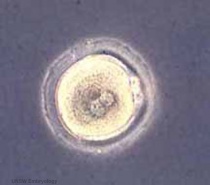
|
to this  in 9 months in 9 months
|
Objectives
- Understand the course objectives and assessment.
- Brief understanding of Australian statistical data.
- Broad overview of Human Development.
| Lectopia Lecture Audio Lecture 1 - Course Introduction
Lecture Date: 2012-05-31 Lecture Time: 17:00 Venue: BioMed F Speaker: Dr Mark Hill |
ANAT2341 Course Background 2012
I will spend the first half going through the current course design, online support and assessment criteria. This is an opportunity to ask the course coordinator questions about the course.
The first 8 weeks of human development.
Links: Course Homepage
Textbooks
Either of the textbooks listed below are recommended for this course and page references to both are given in each lecture. Both textbooks available at campus bookshop. There are additional embryology textbooks that can also be used, consult course organizer. See also Embryology Textbooks
The Developing Human: Clinically Oriented Embryology (8th ed.)
Larsen’s Human Embryology (4th ed.)
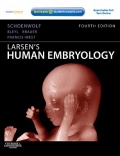
|
Schoenwolf, G.C., Bleyl, S.B., Brauer, P.R. and Francis-West, P.H. (2009). Larsen’s Human Embryology (4th ed.). New York; Edinburgh: Churchill Livingstone.
|
Publisher Links: The Developing Human: Clinically Oriented Embryology | Larsen’s Human Embryology
Recent History
1965 - Neural Crest Research Nicole Le Douarin.
1977 - Thalidomide and its affects on development. Thalidomide
1978 - First IVF baby born. In Vitro Fertilization
1996 - "Dolly the sheep" First adult somatic cell cloning using the process of nuclear transfer.
Nobel Prizes
Much of the modern history of Medicine/Embryology is documented in the Nobel Prizes for Medicine. Remember that these award dates reflect findings that have proven to be scientific key breakthroughs from earlier dates.
- 1986 discoveries of growth factors
- 1995 genetic control of early embryonic development
- 2002 cell cycle
- 2002 cell death
- 2007 embryonic stem cells
- 2010 development of in vitro fertilisation (More? Assisted Reproductive Technology)
21st Century
- 2000 - Human Genome Complete Human Genome
- 2001 talk given by Robert Winston "Engineering Reproduction: Will We Still Be Human At The End of the 21st Century".
- 2009 - Induced pluripotent stem (iPS) Stem Cells
- 2011 - First Successful Transplantation of a Synthetic Tissue Engineered Windpipe Karolinska Institute | University College London | BBC News
- "An international team designed and built the nanocomposite tracheal scaffold and produced a specifically designed bioreactor used to seed the scaffold with the patient´s own stem cells. The cells were grown on the scaffold inside the bioreactor for two days before transplantation to the patient. Because the cells used to regenerate the trachea were the patient's own, there has been no rejection of the transplant and the patient is not taking immunosuppressive drugs."
- 2012 - MRI of Childbirth
| Human Birth MRI |
| Quicktime | Flash |
- Links: Embryology History
Applied Embryology
The information is based upon data from the publication "Australia's mothers and babies 2009"[1] and is provided for educational purposes only. The original full publication is available online from AIHW Perinatal statistics series no. 25.
More births
In 2009 in Australia, a total 294,540 women gave birth to 299,220 babies. There were 296,791 live births and 2,341 fetal deaths. There was a 0.8% increase in the total number of births compared with 2008, but there was a fall in the rate of females aged 15-44 years in the whole population who gave birth (from 64.4 per 1,000 in 2008 to 63.6 per 1,000 in 2009).
- 2009 - 296,791 live births and 2,341 fetal deaths
- 2008 - 294,737 live births and 2,188 fetal deaths
- 2007 - 292,027 live births and 2,177 fetal deaths
Mothers
- Average maternal age in 2009 was 30.0 years compared with 29.0 years in 2000.
- Approximately 41.6% of women were having their first baby.
- Average age for first time mothers was 27.9 in 2009 which was 0.3 years younger than for 2008.
- Of all first-time mothers, 13.7% were aged 35 years or older in 2009, compared with 10.3% in 2000.
- ART was used by 3.6% of women who gave birth. (from available data on assisted reproductive technology (ART) where available)
Antenatal factors
Smoking while pregnant was reported by 14.5% of all mothers and by 37.0% of teenage mothers. In the 4 jurisdictions where data on the number of antenatal visits were available, 97.3% of women who gave birth at 32 weeks or more gestation attended at least one antenatal visit, with 91.9% attending 5 or more.
Indigenous mothers
Of women who gave birth during 2008, 3.8% identified as Aboriginal or Torres Strait Islander. The average age of Indigenous mothers was 25.1 years, compared with 30.1 years for non-Indigenous mothers. Over half of the Aboriginal and Torres Strait Islander mothers reported smoking during pregnancy (50.9%), compared with 14.4% of non-Indigenous women who gave birth.
Labour and delivery
About 3.8% of women who gave birth during 2009 identified as Aboriginal or Torres Strait Islander. Indigenous mothers are younger than non-Indigenous mothers; their average age was 25.3 years, compared with 30.2 years for non-Indigenous mothers. Smoking during pregnancy was reported by half (49.6%) of Indigenous mothers. Of Indigenous mothers who gave birth at 32 weeks or more gestation, 76.8% attended 5 or more antenatal visits.

|
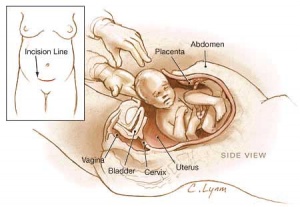
|
| Breech presentation (Galletti, 1770) | Birth caesarean |
Baby outcomes
In 2009, 8.2% of babies were born preterm (before 37 completed weeks of gestation) and 0.9% post-term (42 weeks gestation or more). Overall, 6.2% of liveborn babies were of low birthweight (less than 2,500 grams) and this nearly doubled (10.8%) among mothers who smoking during pregnancy. Less than 1.5% of liveborn babies had a low Apgar score (measure of the baby’s condition at birth). The perinatal death rate was 9.8 per 1,000 births in 2009, which comprised fetal and neonatal death rates of 7.8 per 1,000 births and 3.0 per 1,000 live births respectively.
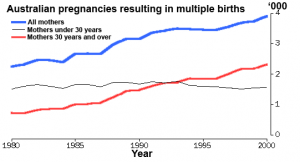
|
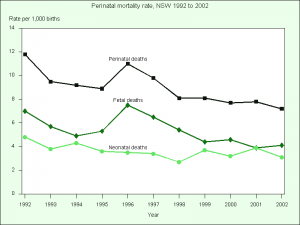
|
| Australian multiple birth data | Perinatal mortality rate NSW 1992-2002 |
Assisted Reproductive Technology
Assisted reproductive technology in Australia and New Zealand 2009.[2] 9 Nov 2011
- In 2009, there were 70,541 assisted reproductive technology (ART) treatment cycles undertaken in Australian and New Zealand.
- Of these cycles, 17.2% resulted in a live delivery (the birth of at least one liveborn baby).
- In total, 13,114 liveborn babies were born following ART treatment in 2009.
- The most important trend in ART treatment has been the increase of single embryo transfer, from 48.3% in 2005 to 69.7% in 2009.
- This trend has resulted in significant reduction of multiple delivery rate from 14.1% in 2005 to 8.2% in 2009. (More? Assisted Reproductive Technology)
References
- ↑ Li Z, McNally L, Hilder L & Sullivan EA 2011. Australia’s mothers and babies 2009. Perinatal statistics series no. 25. Cat. no. PER 52. Sydney: AIHW National Perinatal Epidemiology and Statistics Unit. Viewed 3 January 2012 <http://www.aihw.gov.au/publication-detail/?id=10737420870>
- ↑ Wang YA, Macaldowie A, Hayward I, Chambers GM, & Sullivan EA 2011. Assisted reproductive technology in Australia and New Zealand 2009. Assisted reproduction technology series no. 15. Cat. no. PER 51. Canberra: AIHW. Online Summary | PDF
Australian Developmental Abnormalities
The ten most frequently reported birth defects in Victoria between 2003-2004
- Hypospadias
- Obstructive Defects of the Renal Pelvis or Obstructive Genitourinary Defects
- Ventricular Septal Defect
- Congenital Dislocated Hip
- Trisomy 21 or Down syndrome
- Hydrocephalus
- Cleft Palate
- Trisomy 18 or Edward Syndrome - multiple abnormalities of the heart, diaphragm, lungs, kidneys, ureters and palate 86% discontinued.
- Renal Agenesis/Dysgenesis - reduction in neonatal death and stillbirth since 1993 may be due to the more severe cases being identified in utero and being represented amongst the increased proportion of terminations (approximately 31%).
- Cleft Lip and Palate - occur with another defect in 33.7% of cases.
Teratology
Teratology is the study of abnormalities of development. Some examples of historic teratology studies.
- Rubella <pubmed>1879476</pubmed>
- Thalidomide <pubmed>331548</pubmed>
- Links: Human Abnormal Development | Thalidomide | TORCH Infections | History of Teratology | eMJA - Gregg's congenital rubella
Human Development Timeline
Movies
|
|
|
|
External Links
External Links Notice - The dynamic nature of the internet may mean that some of these listed links may no longer function. If the link no longer works search the web with the link text or name. Links to any external commercial sites are provided for information purposes only and should never be considered an endorsement. UNSW Embryology is provided as an educational resource with no clinical information or commercial affiliation.
The following are links to free iBooks available for background reading.
Gray's Embryology

|
|
The Carnegie Staged Embryos
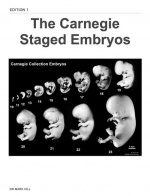
|
|
- 2012 Course: Week 1 Lecture 1 Lecture 2 Lab 1 | Week 2 Lecture 3 Lecture 4 Lab 2 | Week 3 Lecture 5 Lecture 6 Lab 3 | Week 4 Lecture 7 Lecture 8 Lab 4 | Week 5 Lecture 9 Lecture 10 Lab 5 | Week 6 Lecture 11 Lecture 12 Lab 6 | Week 7 Lecture 13 Lecture 14 | Lab 7 | Week 8 Lecture 15 Lecture 16 Lab 8 | Week 9 Lecture 17 Lecture 18 Lab 9 | Week 10 Lecture 19 Lecture 20 Lab 10 | Week 11 Lecture 21 Lecture 22 Lab 11 | Week 12 Lecture 23 Lecture 24 Lab 12
Glossary Links
- Glossary: A | B | C | D | E | F | G | H | I | J | K | L | M | N | O | P | Q | R | S | T | U | V | W | X | Y | Z | Numbers | Symbols | Term Link
Cite this page: Hill, M.A. (2024, May 19) Embryology Lecture - 2012 Course Introduction. Retrieved from https://embryology.med.unsw.edu.au/embryology/index.php/Lecture_-_2012_Course_Introduction
- © Dr Mark Hill 2024, UNSW Embryology ISBN: 978 0 7334 2609 4 - UNSW CRICOS Provider Code No. 00098G

